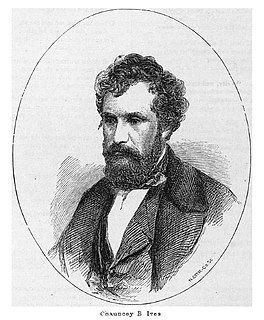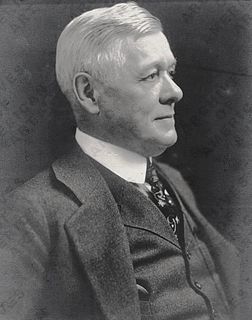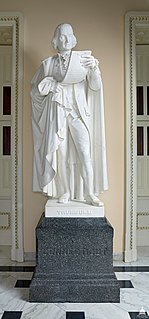
Jo Davidson was an American sculptor. Although he specialized in realistic, intense portrait busts, Davidson did not require his subjects to formally pose for him; rather, he observed and spoke with them. He worked primarily with clay, while the final products were typically cast in terra-cotta or bronze, or carved from marble.

Alexander Milne Calder (MILL-nee) was a Scottish American sculptor best known for the architectural sculpture of Philadelphia City Hall. Both his son, Alexander Stirling Calder, and grandson, Alexander "Sandy" Calder, became significant sculptors in the 20th century.

James Earle Fraser was an American sculptor during the first half of the 20th century. His work is integral to many of Washington, D.C.'s most iconic structures.

Leo Friedlander was an American sculptor, who has made several prominent works. Friedlander studied at the Art Students League in New York City, the Ecole des Beaux Arts in Brussels and Paris, and the American Academy in Rome. He was an assistant to the sculptor Paul Manship and taught at the American Academy in Rome and at New York University, where he headed the sculpture department. He was also president of the National Sculpture Society. In 1936, he was elected into the National Academy of Design as an Associate member, and became a full Academician in 1949.

The Albany Rural Cemetery was established October 7, 1844, in Colonie, New York, United States, just outside the city of Albany, New York. It is renowned as one of the most beautiful, pastoral cemeteries in the U.S., at over 400 acres (1.6 km2). Many historical American figures are buried there.

The history of sculpture in the United States begins in the 1600s "with the modest efforts of craftsmen who adorned gravestones, Bible boxes, and various utilitarian objects with simple low-relief decorations." American sculpture in its many forms, genres and guises has continuously contributed to the cultural landscape of world art into the 21st century.

Clark Mills was an American sculptor, best known for four versions of an equestrian statue of Andrew Jackson, located in Washington, D.C. with replicas in Nashville, Tennessee, Jacksonville, Florida, and New Orleans, Louisiana.

Erastus Dow Palmer was an American sculptor.

Randolph Rogers was an American Neoclassical sculptor. An expatriate who lived most of his life in Italy, his works ranged from popular subjects to major commissions, including the Columbus Doors at the U.S. Capitol and American Civil War monuments.

Chauncey Bradley Ives was an American sculptor who worked primarily in the Neo-classic style. His best known works are the marble statues of Jonathan Trumbull and Roger Sherman enshrined in the National Statuary Hall Collection.

John Massey Rhind was a Scottish-American sculptor. Among Rhind's better known works is the marble statue of Dr. Crawford W. Long located in the National Statuary Hall Collection in Washington D.C. (1926).

Thomas Dow Jones was an American sculptor and medallist. Moses Jacob Ezekiel was his student.

Richard Henry Park was an American sculptor who worked in marble and bronze. He was commissioned to do work by the wealthy of the nineteenth century. He did a marble bust of John Plankinton, an astute businessman who founded the meat industry in Wisconsin and was "Milwaukee's foremost citizen."

Joseph Alexis Bailly was an American sculptor who spent most of his career in Philadelphia, Pennsylvania. He taught briefly at the Pennsylvania Academy of the Fine Arts, which has a collection of his sculpture. His most famous work is the statue of George Washington in front of Independence Hall.

George Washington is a statue by the French sculptor Jean-Antoine Houdon from the late 18th century. Based on a life mask and other measurements of George Washington taken by Houdon, it is considered one of the most accurate depictions of the subject. The original sculpture is located in the rotunda of the Virginia State Capitol in Richmond, Virginia, and has been copied extensively.

Apotheosis of Democracy is a public artwork by American sculptor Paul Wayland Bartlett, located on the United States Capitol House of Representatives portico's east front in Washington, D.C., United States. This sculpture was surveyed in 1993 as part of the Smithsonian's Save Outdoor Sculpture! program.

Henry Jackson Ellicott was an American sculptor and architectural sculptor, best known for his work on American Civil War monuments.

Roger Sherman is an 1872 marble sculpture of Roger Sherman by Chauncey Ives, installed in the United States Capitol, in Washington, D.C., as part of the National Statuary Hall Collection. It is one of two statues donated by the state of Connecticut. The sculpture was unveiled by Senator Orris Sanford Ferry of Connecticut on March 8, 1872.

Jonathan Trumbull is an 1872 marble sculpture of Jonathan Trumbull by Chauncey Ives, installed in the United States Capitol, in Washington, D.C., as part of the National Statuary Hall Collection. It is one of two statues donated by the state of Connecticut. The sculpture was unveiled by Senator William Alfred Buckingham of Connecticut on March 8, 1872.

Horatio Stone, was an American sculptor, physician and writer. He is best remembered for his three statues in the U.S. Capitol.




















